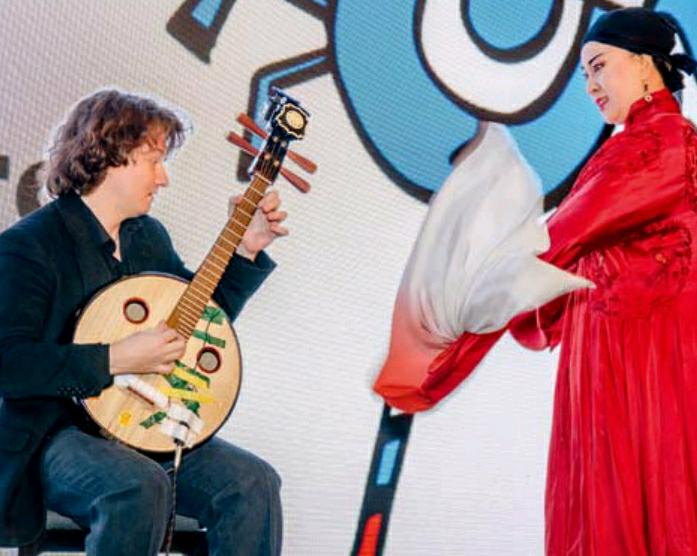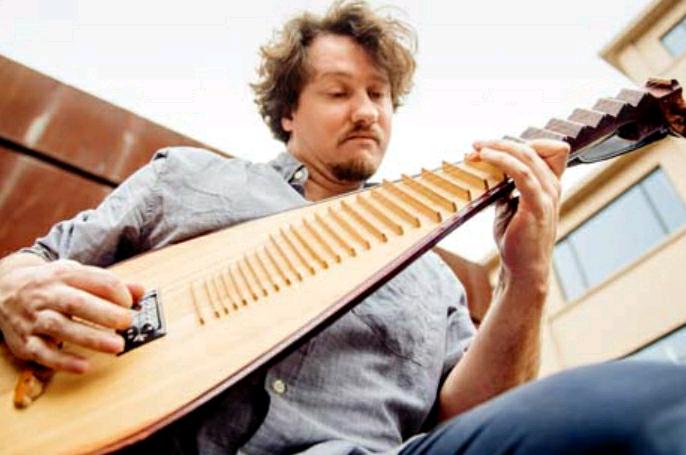Djang San:Electric Zhongruan
2016-09-26byLaurentHou
by+Laurent+Hou
Djang San is a French musician who has been living in Beijing for years. This tireless artist has already composed 38 albums and sings in French, English and Chinese. Djang Sans musical journey led him to electrify the zhongruan (a four-stringed Chinese instrument) and try out the traditional Chinese instrument on a variety of musical genres such as rock, jazz, blues and electronic music. He is committed to bridging cultures through his music and constantly strives to innovate.
China Pictorial (CP): Why did you
choose to play the zhongruan over another Chinese instrument?
Djang San: The sound and overall feeling of the instrument is the biggest reason. Many traditional Chinese instruments made their ways to other East Asian countries such as Japan and Vietnam, where they were modified, but the zhongruan can only be found in China. I was interested in Chinese culture, which made it even more special. The zhongruan has a powerful sound, but can be carried easily when traveling. Such qualities make it a convenient instrument. I have a very special relationship with the instrument. By becoming the first person to electrify it and play it at rock music festivals, I felt like I was bringing it into the 21st Century. Now, more and more musicians are interested in the instrument and have taken inspiration from my work on both the zhongruan and the pipa (an other four-stringed Chinese instrument), which I have also electrified.
CP: You are one of the few foreigners
who can write songs in Chinese and perform them. How did you learn Chinese?
Djang: I started learning Chinese in France at the age of 15 by taking a class in school. I first came to China five years later for more classes, and being here allowed me to improve much faster. Before learning Chinese, I learned English through music, especially singing. I think music is a great way to combine memorization with emotions. So, I tried to do the same with Chinese. I looked for things I liked in Chinese pop music, and in the 2000s, Wang Fei (Faye Wong) was the most interesting pop singer, so I used her songs to study Chinese.

CP: How have Chinese music and culture influenced your work?
Djang: Chinese folk music was a source of inspiration for me. I have used the pentatonic scale sometimes since both pipa and zhongruan are instruments based on it. You can hear the way I use the pentatonic scale on songs like “Wheres Happiness,”“Mad Horses,” “The Other Side” and a few others. I also took inspiration from Chinese poets like Ma Zhiyuan and Liu Yuxi. Along with the zhongruan, I also play other Chinese instruments. You can see me playing some of them at my live shows. Others, I mostly use when recording albums. I play the pipa, guzheng (Chinese zither), hulusi(cucurbit flute), xiao (a Chinese vertical flute) and xun (a traditional egg-shaped, holed wind instrument). I want to bridge cultures. I have been constantly mixing Chinese music with rock, blues and elec- tronic music. Jazz is also an increasingly important influence in my work. I already used instruments from Brazil and Peru, the country where I spent part of my childhood. I plan to keep on broadening my musical horizons and use instruments from other cultures too. In the future, I might use Japanese and Korean instruments, and even old European instruments from the Middle Ages.